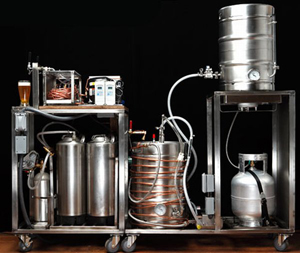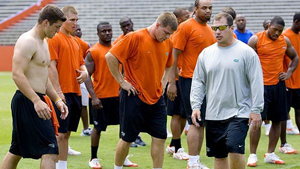Recently I bottled a home-brewed beer. Let me assure you, there are few things in life that make you feel more a man than literally bringing alcohol to life in your own kitchen. I’ve never tried Alaskan crab fishing or lumberjacking in the Pacific Northwest, but I’d imagine beer brewing ranks close to those on the 2013 Chest Hair MeterTM.
 Home-Brewing Silver Bullets
Home-Brewing Silver BulletsWhile transporting our beer to bottles I started thinking, "wow this is a lot like the Buckeye football offseason."
Hear me out on this, I'm willing to explain.
In order to understand, we’ll have to go over a few things upfront. For those of you who aren’t familiar with the beer brewing process I’ll topline it for you. Obviously there are a myriad of beer brewing intricacies out there and the specifics of the process differ from brew to brew. However, at a high level, you can boil it down (pun intended) to four key steps:
- Brewing
- Cooling and Fermenting
- Priming and Bottling
- Drinking
Got it? Good. Let’s jump right in to this step-by-step guide to creating a tasty Buckeye brew.
Brewing
First and foremost you’ve got to get some water boiling. You know, really get those water molecules hyped.
The same is happening right around this time during the offseason. Recruiting, and National Signing Day, get the proverbial water boiling in Columbus. The heat rolling off of that top recruiting class is palpable.
Once you get your water to the perfect temperature you’ve got to steep your grains, then add hops and malt.
Grains are the existing players and the hops and malt (the parts that give your mixture that new, unique flavor) are incoming recruits. Look for Urban Meyer to "steep" the existing players during the spring game, giving them as much playing time as possible while peppering in a few new recruits here and there for taste.
 "The Great Fermenter"
"The Great Fermenter"Cooling and Fermenting
At this point, the mixture you’ve got is called “wort”. You’ve got to quickly cool the wort and add yeast. This step is crucial. If your wort is too hot, you’ll kill off the yeast, which is essentially what feeds on the mixture and turns it into alcohol (fermenting). Long story short: DON’T KILL THE YEAST.
After the excitement of National Signing Day and the spring game die down, things start to cool off for Ohio State football as well. But rest assured, the dearth of football news does NOT indicate a lack of activity. In actuality, magical things are happening.
It’s at this point that Urban Meyer unleashes his “yeast”: Mickey Marotti.
Much like the yeast of a brew, Marotti goes to work immediately, eating away at the mixture he’s been given via strenuous workouts, lift sessions and nutrition plans to transform the “wort” into something much more valuable.
During a homebrew, you let the yeast go at it for roughly a month, but Meyer allows his yeast to operate for much longer. Throughout the summer months, Marotti is the “great fermenter".
Priming and Bottling
At this point you’ve got alcohol, but it's still got a few hoops to jump through to become a product fit for imbibing.
Priming sugar is added to the alcohol to act as additional fuel for the yeast and it’s transferred to bottles for approximately 2-3 weeks of aging. During this process the yeast eats away at the priming sugar and creates carbon dioxide (the stuff to thank for freshies that aren’t flat).
Much like the beer, once Marotti is done fermenting, the team is collected and transferred to a different location as well: training camp.
During training camp a number of priming sugars are added including additional coaches, playbooks, position drills and hitting, hitting, hitting.
Add in an additional week of “aging” in the form of game-one practices and the hope is the team has the necessary sophistication and “pop” to satisfy a much larger audience in the next step.
Drinking
Well the time has come. As a homebrewer you’ve put in the work, time and effort to field a solid brew and now you’ve got to invite people over to give it a taste. As an old-fashioned brewer, you haven’t sampled the beer pre-party as you want to experience your creation in tandem with your closest friends.
This is a particularly nerve-racking time. You’ve followed the right steps to a T, but even so, you’re not quite sure what you’ve got.
It looks like beer in the bottles, but until you crack one open and take that first swig, your beer’s “talent” is a mystery.
I think you see where I’m going with this.
I’m sure this cautious optimism is an emotion experienced by each and every college football coach on that first gameday of the season.
They’ve done everything they could, following the offseason recipe developed years ago by their mentors while adding in a few of their own ingredients.
Still, a recipe isn’t enough. Ultimately, all of the pieces have got to come together organically to field a crowd pleaser.
Unfortunately for those coaches, their “crowd” is much larger than the 15 people you invited to your beer unveiling. If something went wrong with their offseason mixture, they’ve got to hear about it via tens of thousands of skunky beer faces.
But that’s not the only route a coach’s brew can take. Sometimes if everything goes just right, the result is a nectar of the gods.
So you see Urban Meyer is really just homebrewing. The unbottling is scheduled for August 31, 2013.

